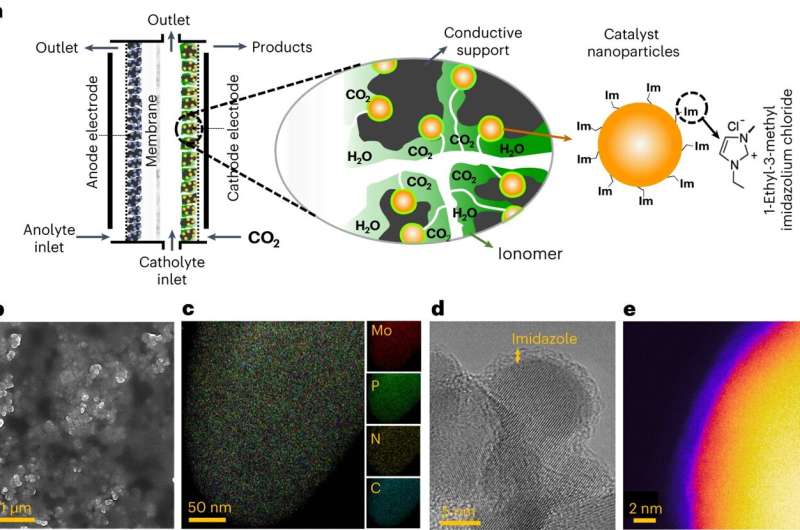This article has been reviewed according to Science X's editorial process and policies. Editors have highlighted the following attributes while ensuring the content's credibility:
fact-checked
peer-reviewed publication
trusted source
proofread
Researchers develop new carbon-capture solution for a cleaner, more energy-dense fuel source

Over the past three centuries, especially since the Industrial Revolution in the late 18th and 19th centuries, human activities have significantly increased greenhouse gas levels in the Earth's atmosphere. The main culprits are fossil fuel consumption, industrial processes, deforestation, and waste management.
In response, the United States aims to cut greenhouse gas emissions by 50 to 52% from 2005 levels by 2030. This initiative aligns with a global effort to achieve net-zero greenhouse gas emissions by 2050. With electric power and industry sectors contributing to about half of U.S. carbon dioxide (CO2) emissions, finding solutions in these areas is imperative.
Now, in a paper published in Nature Energy, researchers from the University of Pennsylvania, Illinois Institute of Technology, and the University of Illinois at Chicago have developed a system that can convert CO2 emissions into propane (C3H8), a cleaner, more energy-dense fuel source.
"Electrochemical conversion of CO2 can serve future energy needs by storing renewable energy and closing the anthropogenic carbon cycle," says co-author Andrew Rappe of the School of Arts & Sciences at Penn. "This research paves the way to new solutions that will tackle energy storage challenges and meaningfully reduce CO2 levels."
"Making renewable chemical manufacturing is really important," says co-author Mohammad Asadi of Illinois Institute of Technology. "It's the best way to close the carbon cycle without losing the chemicals we currently use daily."
Copper has traditionally been the go-to element for researchers investigating efficient ways to convert CO2 into valuable chemicals and fuels, both to curb its environmental impact and provide new energy storage solutions. However, the fuels produced have been low-energy density single-carbon compounds like methane.
"Getting energy-dense multi-carbon products like C3H8 has remained a challenge due to the many intermediates that form throughout the chemical conversion process," explains Zhen Jiang, co-first author of the paper and a former postdoctoral researcher in The Rappe Group. "Additionally, most strategies to increase a material's selectivity for multi-carbon molecules tend to be energetically costly."
Jiang says that the team sought ways to move beyond existing catalysts like copper—and their modest selectivity for multi-carbon products or their sluggish kinetics—and investigated ways to add ionic liquid (IL) into the catalytic system. This prompted the team to look at tri-molybdenum phosphide (Mo3P) as the catalytic material.
"Based on our theoretical simulations, we found that the IL layer can enhance the adherence of CO2 and subsequent groups during reaction on the Mo3P catalyst surface, thus stabilizing the intermediates at different sites along the surface to produce C3H8 with an unparalleled efficiency of 91%," says Jiang.
The team also notes that this key finding led to a new paradigm for exploring the relationship between materials in electrocatalytic systems.
"Conventionally, the solid-state catalyst, and the aqueous solution that bridges ion transfer throughout the reaction acted with less mutual promotion at the interface," says Jiang. "But now, we can apply a hybrid approach via techniques like IL coating on solid-state catalysts and re-examine previously tried systems with our novel understanding of the catalyst's microenvironment."
Looking ahead, the researchers plan to build on this research in two ways: one, to develop a catalog of ionic liquids and their effectiveness in fuel-generating catalysts and other electrochemical systems; and two, investigate new catalysts for the conversion of CO2 into more energy-dense fuel sources from fuel gas to light oil with more carbon atoms.
Rappe says, "Extending this research to higher-weight hydrocarbons could close the carbon cycle by creating natural gas, propane, gasoline, and even jet fuel directly from the CO2 made by previous fuel combustion. In this way, the same carbon atoms store energy over and over, and we don't release them into the atmosphere."
More information: Mohammadreza Esmaeilirad et al, Imidazolium-functionalized Mo3P nanoparticles with an ionomer coating for electrocatalytic reduction of CO2 to propane, Nature Energy (2023). DOI: 10.1038/s41560-023-01314-8















